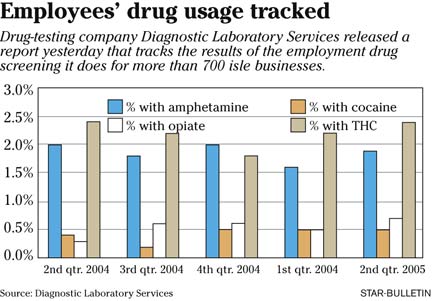2% test positive
for ‘ice’ use
Job seekers and workers
screened knew they were
going to be tested
Nearly two out of every 100 people who undergo pre-employment and random workplace drug screening in Hawaii test positive for crystal methamphetamine, or "ice," the state's largest drug testing laboratory has found.
Of the 9,419 prospective and current employees screened by Diagnostic Laboratory Services in the first three months of this year, 179, or 1.9 percent, tested positive for ice. In the previous 12 months, 1.8 percent tested positive.
"We always knew ice was a problem here, but we didn't look at it in an organized way," said Carl Linden, the lab's scientific director.

The report released yesterday is the first study to track drug usage based on hard drug test data among the broadest sampling of the state's population.
Previous studies are based on self-reporting surveys, while those that do use hard drug test data involve smaller populations like prison inmates or arrested crime suspects.
Linden said he believes the number of ice users in Hawaii is probably higher than the data suggests because the subjects knew they were going to be tested and because ice does not stay in people's systems for a long time. But he said it is probably not as high as the estimates quoted by law enforcement leaders just two years ago.
During discussions organized by the state Legislature and Lt. Gov. James "Duke" Aiona in 2003, law enforcement leaders said 120,000 people, or about 10 percent of Hawaii's population, were either hard-core or recreational ice users.
State drug control liaison Tamahalani Noh also said the data understates the true size of the ice problem in Hawaii, but she is excited with its release.
Linden said the data's value is in tracking usage trends to help policy-makers decide where to focus education, law enforcement and treatment efforts.
One of the trends he noted is a more-than-doubling in the detection of opiate drugs to 0.7 percent this year from 0.3 percent last year. State administrative rules allow drug testing laboratories to confirm whether the detected opiate is morphine or codeine, but not for prescription drugs like oxycontin and vicodin, whose use is on the rise, Linden said.
Marijuana usage ranks highest in Hawaii at 2.4 percent, while cocaine use, at 0.5 percent, remains low.
The marijuana number is lower than the national average. But that could be because the threshold for tetrahydrocannabinol, the active ingredient in marijuana, for a positive declaration in Hawaii is twice as high as the federal level and those of many states, Linden said.
E-mail to City Desk
[News] [Business] [Features] [Sports] [Editorial] [Do It Electric!]
[Classified Ads] [Search] [Subscribe] [Info] [Letter to Editor]
[Feedback]
